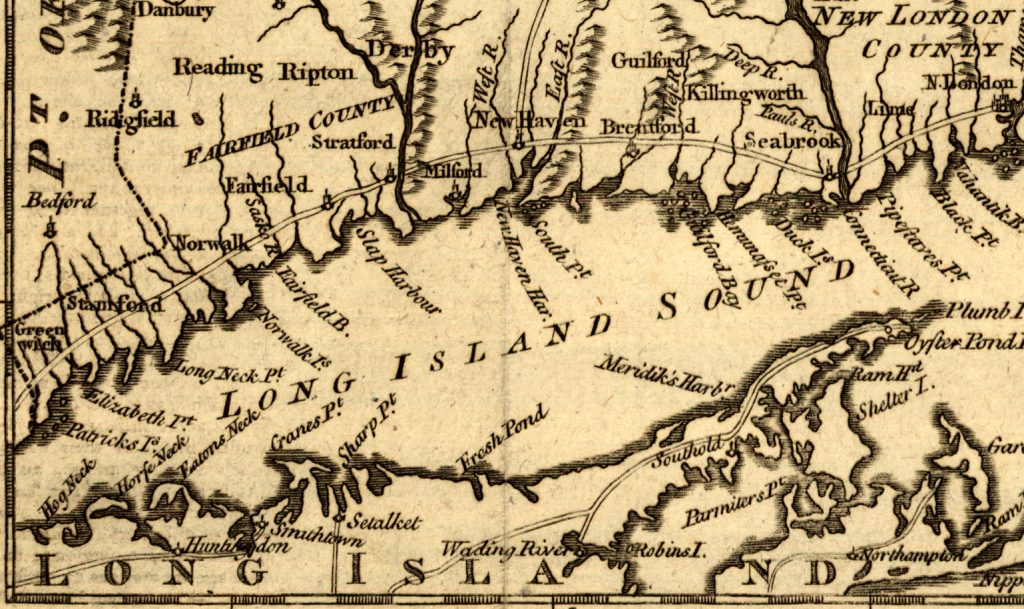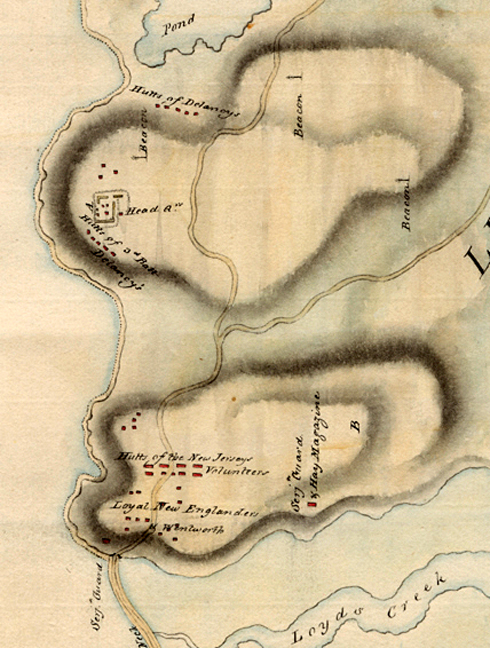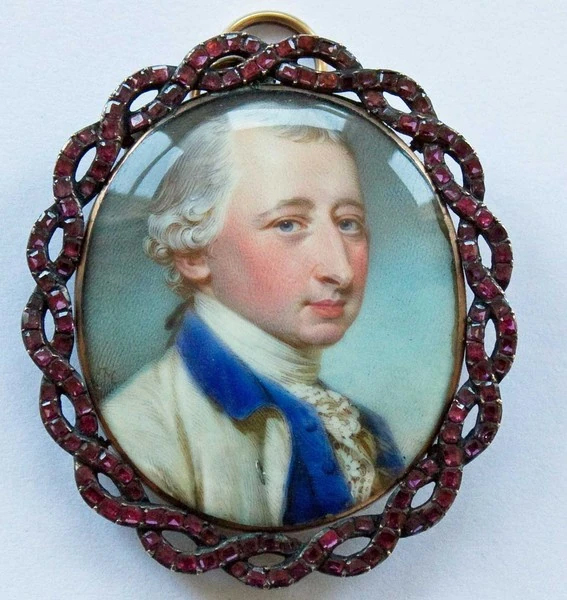Queens County of Long Island, New York, had an overwhelming Loyalist population throughout the Revolutionary War period. After the war many Loyalists remained on the island and assimilated into the local population. It is estimated that a large majority of Long Islanders who were loyal and stayed in the United States after the war lost the right to vote due to the punitive measures of the Act of Disenfranchisement of 1784. The number of citizens affected, estimated at ninety percent of the population, hints at the size of this wartime loyal faction on Long Island.[1] It is no wonder why British-occupied Long Island between 1776 and 1783 became a haven for displaced Loyalists. The largest of these refugee posts was known as Lloyd’s Neck. We know much about the eventual fate and relocation of the Loyalists to Canada at war’s end, but the personal stories of wartime Loyalist refugees give us much insight into the challenges and unfortunate circumstances of their wartime survival and the importance of their asylum on Long Island.
During the 1770s hundreds of loyal citizens of the county of Fairfield and other towns along the coast of southern Connecticut were forced out of their homes due to rebel sympathies in their communities. The Rev. John Sayre, a missionary at Fairfield, Connecticut, wrote of the hardships endured by the Loyalists at the hands of the contending parties. In his church, the hangings were torn down, bullets were fired through the windows and the building was damaged. The reverend was publicly declared an enemy to his country and local citizens were forbidden to deal with him. He eventually was forced to leave his home.[2] He wrote in a letter dated November 8, 1779,
On the 7th day of July last Major-General Tryon landed at Fairfield with a body of the inhabitants having tackled their teams and removed what they could on his approach. This cut off all hopes from the few Loyalists of saving any part of their effects if the town could be burnt, every carriage being taken away. The General was so kind, when he had resolved to commit the rest of the town to flames; for, as I had already hinted, I had determined to remain at home. But the ungovernable flames soon extended to them all, and in a few minutes left me with a family consisting of my wife and eight children, destitute of food, house and raiment. Thus reduced, I could not think of remaining in a place where it would have been impossible to have clothed and refurnished my family.’[3]
Rev. Sayre’s family, like many other displaced Connecticut Loyalists, was forced to cross Long Island Sound to seek shelter behind the British lines.
Along the north shore of Long Island the King’s troops had built garrisons to secure forage routes and protect resources. The establishment of a post on Lloyd’s Neck, opposite the land and coves between Norwalk and Stamford in Connecticut, became the most desired location for the fleeing loyalist refugees. Walter Bates of Stamford, who was driven into the mountains and woods for refuge, wrote that his three brothers and hundreds of others passed by in the night continually to the British headquarters at Lloyd’s Neck.[4] Lloyd’s Neck was an isthmus of land that was essentially an island at high tide. Its land bridge was very narrow and the heights closest to the mainland provided an adequate defensive position from all sides. Initially the location, which was to become a British and Loyalist headquarters on Long Island, was a woodcutter’s camp. It developed into a fortified work and troop camp with the establishment of Fort Franklin on the heights of its south-western bluff. Its adjacent waterfront provided a shipping and supply dock. Lloyd’s Neck was well supplied, being abundant with apple, peach, and plum trees, wheat and corn fields, and woods filled with deer, quail, and wild turkeys. There were acres of timber, and the soil had clay deposits that could be used for pottery. The waters were filled with fish, clams, and oysters.[5]

Many Loyalist regiments and detachments were garrisoned at the Neck. The largest contingents and longest to garrison included the 3rd Battalion of Delancey’s Brigade, Governor Wentworth’s Volunteers, the Loyal New England Regiment, the 2nd Battalion of the New Jersey Volunteers, the Volunteers of New England, the Associated Loyalists, and the King’s American Dragoons. There were also, for different periods, detachments of the Queen’s Rangers, the Prince of Wales Regiment, the Loyal American Regiment, and the King’s American Regiment.[6]

The non-military Loyalists seeking refuge lived under the pretense of semi-security from the troops. They were not provided with food by British forces, instead providing for their families by farming and wood cutting and aiding in British efforts to supply New York City. The bluffs that provided defense for Fort Franklin also provided defense for the refugee camps positioned on the ridges south of the fort. It is estimated that the camps reached a population of 800 men, with 500 of these being armed.[7] Fort Franklin and the encampments were subject to repeated attacks and pillaging during the war, sometimes with prisoners being carried off. As the war progressed even this southern inward shore of the neck was subject to a constant threat of attack and robbery from rebellious inhabitants of mainland Huntington on Long Island.[8]
Conditions in the camp were recorded by B. Birdsall in 1782 in a letter to British commander in chief Gen. Henry Clinton: “I effected a four weeks’ disagreeable journey—was sixteen days on the Island, during seven of which I was in camp on Lloyd’s Neck. The fare in the camp is hard. It is the wickedest place I ever met with. There was no restraint, I noticed everything. The large farmers and traders do well, others are worn out. There were thirty wood vessels at Huntington Harbor convoyed by three small privateers called the ‘Lloyd’s Neck fleet.’ A ton of hay cost the King 30pds.”[9] The camps housed Loyalist soldiers and their wives and children. and also sheltered wood cutters and their families. They most likely utilized any wooden buildings or barrack shelters for the harsher months and tent camps during the warmer season.
The personal story of another refugee at Lloyd’s Neck, Rev. Dr. William Walter, gives us some insight into the Loyalists’ hardships during the war. His former congregation was in Boston and his history records that he tried to maintain a neutral stance between the Loyalists and Revolutionaries within his church early in the war. Reverend Walter remained well-liked by both sides until 1776 when he was accused of trying to spread smallpox in the Patriot Army. The incident involved a servant boy who accused him of being forced to be inoculated. People who were inoculated could spread the disease to others for a period of time, so they had to go into temporary quarantine. The servant boy claimed that the reverend instructed him to go to the Patriot army at Point Shirley; there the boy came down with smallpox. Certain Bostonians accepted the boy’s story and accused Reverend Walter of trying to spread smallpox. They branded him a Loyalist and traitor. He and his family left Boston for Halifax during the evacuation of 1776 and his house was then ransacked.[10] He eventually went to New York and became the chaplain of the 3rd Battalion of Delancey’s Brigade. William Walter had been a classmate of the American Gen. Samuel Parsons at Harvard, and the two corresponded at length throughout the war. On October 1, 1780 Walter wrote from Lloyd’s Neck, where 3rd Battalion Delancey’s was stationed, inquiring “after the health of my old friend and his family, and to acquaint you that the household of Walter are all well. Long before this I had hoped that this horrid war would have had an end and that I should have been able to meet you and others in the opposition on the ground of peace and friendliness, but this happy period has not yet arrived. When it will is uncertain, and till it does I am contented to remain in patience, only lamenting the sad distresses which accrue to individuals and the public from the continuance of it.”[11] His writing attests to his empathy for friends from his former home.
Another refugee, Joseph Lyon from Redding, Connecticut, was a Loyalist who was persecuted and attacked by a mob in his hometown and had to go into hiding. He fled to the Connecticut woods with Ephraim Deforest, another loyalist, and stayed in a hideout for thirty-three days. They built a cave to shelter other homeless loyalists in the area.[12] Deforest left the Redding area and volunteered with the Loyalist forces on Long Island. He was first an ensign under Brig. Gen. Montfort Browne in 1776 and then served in Delancey’s Brigade at Lloyd’s Neck. During this period he was arrested twice and claimed to have suffered greatly in prison.[13] Joseph Lyon found opportunity to escape to the British lines in April, 1777 when Tryon’s Expedition marched through Connecticut. He eventually entered the regiment known as the Associated Loyalists and served on several occasions as a volunteer at Lloyd’s Neck.[14]
John Lyon, a sibling of Joseph Lyon, also fled Redding because of death threats from his neighbors. He left his wife Hepzibeth with a baby waiting to be born and six other children in Connecticut to flee to safety in New York. He joined the Prince of Wales American Volunteers, becoming a captain; he saw action defending the post at Lloyd’s Neck. Hepzibeth, with her seven children, eventually made a fearful escape from the Connecticut coast to finally be re-united with her husband. Lyon was finally able to meet his newborn son for the first time. During their years as refugees at the Neck they made many new friends, most of whom were other Connecticut loyalists.[15]
The sufferings of the Loyalists on Long Island were also not free of hardship from the British side. Judge Thomas Jones wrote of the conduct of some soldiers quartered on Long Island, “They robbed, plundered and pillaged the inhabitants of everything they could lay their hands upon. It was no uncommon thing, of an afternoon, to see a farmer driving a flock of turkeys, geese, ducks or dunghill fowls and locking them up in his cellar for security during the night. The whole day it was necessary for a person to attend in the field where they fed to protect them from the ravages of the military.” He continued, “To complain was needless. The officers shared in the plunder.”[16]
The Lyon and Deforest families’ plight as refugees on Long Island came to an end in 1783 with the war’s conclusion. The families sadly accepted offers to create new homes in the northern colony of Nova Scotia. They sailed away with what was to become known as the Spring Fleet, the first fleet of transports carrying refuges from the New York area to the St. John River in Canada.
The stories of the Loyalists on Long Island and of the largest Loyalist refugee camp of the Revolutionary War have long been forgotten in the local histories of the region. The once-extensive abode of so many distraught and affected in the beginnings of America remain hidden to this day. Very few know of the former importance of this historical site on Lloyd’s Neck, an unawareness that remains part of the enduring disdain and unfortunate history of a loyal citizenry on the losing side of a civil conflict.
[1]Andrew C. Batten, “Long Island’s Loyalists: The Misunderstood Americans,” The Freeholder: the History Magazine of the Town of Oyster Bay, Vol. 3 No. 4 (Spring, 1999), 3-5.
[2]Walter Bates, W. O. Raymond, and Sarah Frost, Kingston and the loyalists of the “spring fleet” of 1783 with reminiscences of early days in Connecticut (Fredericton, NB: Non-Entity Press, 1980).
[3]E. Hubbell (Godfrey) Schenck, The history of Fairfield, Fairfield County, Connecticut, from the settlement of the town in 1639 to 1818 (New York: Published by the Author, 1889).
[4]Wilbur Henry Siebert, The Refugee Loyalists of Connecticut (Ottawa: Printed for the Royal society of Canada, 1916).
[5]Stephen Davidson, “A Loyalist Refugee Camp,” Loyalist Trails UELAC Newsletter, 2009-31: August 2, 2009.
[6]National Archives of Canada RG 8, Series I (“C” series), Vol. 1895, Loyalist Muster Rolls.
[7]Benjamin Tallmadge, Memoir of Colonel Benjamin Tallmadge (New York: T. Holman, 1858).
[8]Lois J. Meyer, The Irony of Submission: the British Occupation of Huntington and Long Island, 1776-1783 ([Place of publication not identified]: R.B. Langhans, 1992), 19.
[9]Henry Onderdon,. Queens County in Olden Times (Jamaica, NY: C. Welling, 1865), 57.
[10]Clifford Kenyon Shipton, John Langdon Sibley, Sibley’s Harvard Graduates (Boston: Harvard University Press, 1933), 113.
[11]William Walter to Samuel Parsons, October 1, 1780, Samuel Parsons and Parsons Family Papers, 1703-1865, Connecticut Historical Society.
[12]William Edgar Grumann, The Revolutionary Soldiers of Redding, Connecticut (Hartford, CT: The Case, Lockwood and Brainard Company, 1908), 199.
[15]Stephen E. Davidson, The Burdens of Loyalty: Refugee Tales from the First American Civil War (Saint John, NB: United Empire Loyalists’ Association of Canada, 2015).
[16]Thomas Jones and Edward F. De Lancey, History of New York during the Revolutionary War (New York: New York Historical Society, 1879).








3 Comments
I enjoyed reading this article, which does an excellent job of profiling an important Loyalist stronghold–one that indeed has been often overlooked. The frequent raids (and smuggling) that went on across Long Island Sound were a source of aggravation for commanders on both sides, none less than Colonel William Ledyard of New London. It appears that one of the many objectives of Benedict Arnold’s raid there on September 6, 1781 was to prevent an expedition being planned by Connecticut Governor Jonathan Trumbull to attack Fort Franklin. Correspondence in the Trumbull Papers at the Connecticut State Library between Thomas Mumford of Groton and Governor Trumbull in August and September 1781 clearly hints at such an objective–and the effectiveness of Arnold’s Raid becomes evident in Mumford’s letter to Trumbull dated September 9, 1781: “I can give your Excellency no encouragement from our privateers, the Two Brig’t I am concerned in are sunk/to save them/their Sails and Riggin all consumed in Stores, one other has no guns, so that only one remains fit for duty, unequal to the plan proposed.”
It is well documented, of course, that many Connecticut Loyalists from Lloyd’s Neck were on the New London Raid.
Thank you for your most interesting article on the Long Island loyalist refugees. I have tried to find information on William Franklin’s Associated Loyalists ‘army’. I cannot find anything specific about their actual number, not even in Mark Daniel Epstein’s excellent biography.
In your opinion, would their number have reached 500, 1000 or more? It sounds like a trivial question but there seems to be practically nothing about their history (recruitment, operations in Long Island Sound and on the Connecticut coast, what happened to them after Yorktown).
Thanking you in advance for any light on this matter.
All the best
Thank-you for your interest in the article and for reaching out. There is very little written about the Associated Loyalist’s and I agree the information is hard to come by. I had previously done some research on the unit and at that time was able to find a number for the unit of 305 men listed in a primary report source called, ‘Proceedings of a Board of General Officers of the British Army at New York, 1781”. The unit is sometimes in other sources lumped in with troop strengths for refugees and/or listed as Loyalist Refugees. Hope this helps.